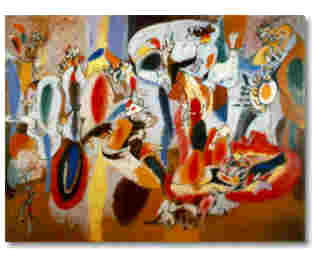



(l904-1948)
Gorky's encounter with European Surrealism during the 1930s enabled him to free himself from Cubistism, and to infuse his abstractions with lyrical allusions to the myths of his childhood in Armenia. His letters to his sister and family attest to his nostalgia, but also to his view of the function of art, which he saw as discrete from social commentary or direct messages. Along with de Kooning and Pollock, Gorky was considered one of the strongest figures in the early years of Abstract Expressionism.
GORKY'S THOUGHTS ON ART
"My dearest ones, the camera has rendered impotent any attempt to compete with it. This has to be accepted as a necessary and a scientific advance. hat reason, therefore, remains to sit in realism's stagnation? Art is more than mere chronicle. It must mirror the intellect and the emotion, for anyone, even a commercial artist or illustrator, can portray realism. The mind's eve in its infinity of radiations and not optical vision of necessity holds the key to truth. It is left for the artist to forge the new metal, to resurrect his ancient role as the uncoverer and the interpreter, but never the recorder, of life's secrets.
Beloveds, the stuff of thought is the seed of the artist. Dreams form the bristles of the artist's brush. And, as the eye functions as the brain's sentry, I communicate my innermost perceptions through art, my woridview. In trying to probe beyond the ordinary and the known, I create an interior infinity. I probe within the finite's confines to create an infinity. Liver. Bones. Living rocks and living plants and animals. Living dreams. [1939]
INTRODUCTION WHAT ART IS SPIRIT OF ART REFLECTIONS BY ARTISTS MY WORKS OF ART